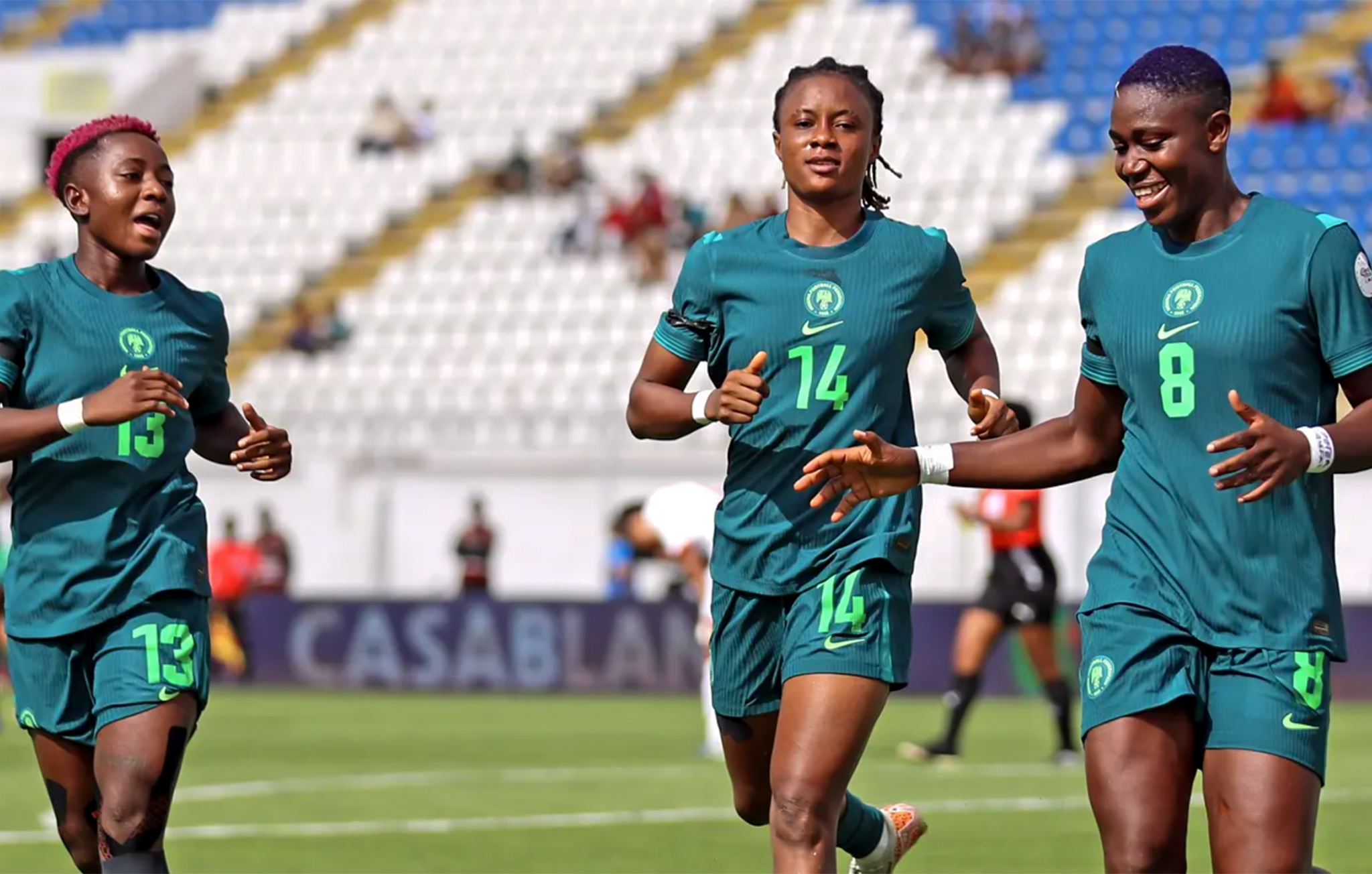As infrastructure, visibility, and support gain ground, African women’s football is entering a long-overdue era.
A new trophy, record crowds, increased prize money, and historic investment for Women’s AFCON in Morocco, which kicked off on Saturday, 5 July, reflect a change happening in African women’s football.
Delayed by a year, marred by funding gaps, and clouded by persistent pay disputes, the Women’s Africa Cup of Nations (WAFCON) has long trailed its male counterpart in support and scale.
This year’s edition, however, is not just a top-tier competition but a milestone for recognition.
According to the Confederation of African Football (CAF), this year’s tournament features a 45% increase in total prize money. The winners will receive US$1 million, double the previous figure. More than 150,000 female players are now registered across the continent, alongside nearly 8,000 registered female referees.
“This tournament is not just about football. It is about visibility, legitimacy, and economic inclusion for African women in sport,” said CAF President Patrice Motsepe during the opening ceremony in Rabat. “The new trophy reflects not only triumph but the long struggle to be seen.”
Federations across Africa are stepping up. In Nigeria, despite unresolved pay disputes, the Super Falcons enter the tournament as 11-time champions with heightened media support.
Zambia’s Copper Queens arrived with stars like Barbra Banda and Racheal Kundananji, both fresh from high-profile transfers.
Kundananji made headlines in February 2024 when she became the most expensive female footballer in history, signing with Bay FC in the United States for US$860,000.
Banda joined Orlando Pride in the NWSL shortly after, further underscoring global demand for African talent.
Both players led Zambia’s qualification campaign. Banda scored a hat-trick against Cameroon in a decisive qualifier. Kundananji added six goals across the final three fixtures.
Uganda’s Finance Trust Women Super League has seen its viewership more than double over the past year.
Charmar News reports that online match audiences surged after Finance Trust Bank invested UGX 2 billion (approximately US$540,000) into the league in August 2024.
This sponsorship enabled weekly livestreams on YouTube and Facebook. Key matches now draw between 50,000 and 100,000 viewers, up from fewer than 10,000 a year ago.
According to NBS Sport, the deal also funded infrastructure upgrades, coaching development, and club licensing reforms. Daily Monitor notes that physical match attendance has also grown, with Kampala Queens and She Corporate drawing crowds of 2,000 to 3,000, compared to fewer than 500 in previous seasons.
FIFA officials say the number of registered female players has jumped from under 100 in 2014 to more than 6,500 in 2025, a shift driven by sustained investment and growing public interest.
Already, some countries in the region are reaping early success for women’s teams. Kenya’s Harambee Starlets, for instance, made history in February 2025 by defeating Tunisia 1–0 in Sousse. It was their first win in North Africa in 19 years and secured a spot in the WAFCON 2026 qualifying final round.
Their strong form continued at the June 2025 CECAFA Championship. They beat Uganda 4–0, Burundi 3–0, and South Sudan 4–0, claiming three consecutive clean sheets and topping their group.
On the youth front, Kenya’s U-17 Junior Starlets became the country’s first team ever to qualify for a FIFA World Cup. They secured a spot in the 2024 U-17 Women’s World Cup in the Dominican Republic after defeating Burundi 5–0 on aggregate in the final playoff.
North African countries are also bolstering their foundations. Algeria and Tunisia have launched grassroots academies to grow the women’s talent pipeline.
Africa Soccer reports that Algeria opened its first FIFA Arena mini-pitch in Algiers in May 2025. The facility is part of a grassroots programme targeting over 1,500 children, including girls, to expand early football access.
The initiative is supported by more than US$4.2 million from the FIFA Forward programme. In Tunisia, the federation secured US$250,000 through the FIFA Talent Development Scheme in 2024 to strengthen girls’ academies and youth training.
The country also hosted the first-ever UNAF U-17 Women’s Tournament in late 2024, a key scouting ground for regional talent.
Morocco, as host, stands out as a model of elite development. The country is hosting WAFCON for a second consecutive time and will do so again in 2026. It launched a new national women’s football academy this year and appointed World Cup-winning coach Jorge Vilda to lead the national team.
Zambia’s Banda and Kundananji have become icons for a rising generation of footballers. Their success stories, from grassroots academies to global transfers, reflect the value of long-term investment.
Crowds in Casablanca and Rabat have matched the energy of men’s tournaments. Fans have filled stadiums with chants, flags, and face paint.
“I’ve never seen this many families attending a football match together,” said Fatima Zahra, a fan who travelled from Fez for the opening match. “This feels like our game now.”
Public screening venues in Lusaka have also drawn thousands of fans.
“When Banda scores, the entire neighbourhood erupts,” said 22-year-old fan Nchimunya Mulenga. “She’s more than an athlete—she’s a beacon.”
The tournament’s opening clash between hosts Morocco and Zambia delivered early drama. The 2–2 draw featured goals from both Banda and Kundananji in the first half hour. Morocco responded with tactical discipline and a late equaliser under coach Vilda.
Analysts praised Morocco’s structure and balance.
“They’ve found a rhythm tactically, emotionally, and in terms of squad cohesion,” said African football analyst Mimi Fawaz.
Zambia showed pace and flair but lacked consistency in midfield transitions, an area they must strengthen to contend for the title.
CAF’s support is reinforced by corporate backing, notably from TotalEnergies. Morocco’s royal family has also heavily invested in sports infrastructure, including the US$65 million King Mohammed VI Complex, widely regarded as one of Africa’s best facilities.
WAFCON is now doubling as a springboard for broader reforms. CAF announced that it will alternate between men’s and women’s tournament hosting each year to boost year-round visibility. Plans are also underway for a women’s U-17 continental championship and an expanded women’s Champions League.
“We’re still far from equality, but moments like this reshape the narrative,” said Moroccan striker Ibtissam Jraidi. “It’s no longer a question of whether women belong in African football. We are here. We are the future.”
bird story agency
African women's football is experiencing a significant transformation with increased infrastructure, visibility, and support, highlighted by the recent Women's Africa Cup of Nations (WAFCON) in Morocco. This year's tournament marks a milestone with a 45% increase in prize money, media attention, and recognition from the Confederation of African Football (CAF). Notable teams and players are gaining prominence, such as Nigeria's Super Falcons, Zambia’s Barbra Banda, and Racheal Kundananji, whose high-profile transfers reflect the growing demand for African talent.
Countries like Uganda, Kenya, Algeria, and Tunisia are investing in women's football through infrastructure, academies, and financial backing, leading to increased participation and competitive performances. Morocco, as host, exemplifies elite development and investment in sports facilities. The surge in viewership, attendance, and grassroots support illustrates a cultural shift in African women's football, making it more accessible and popular.
With continued corporate and institutional support, women's football is becoming a platform for broader reforms, including alternating tournaments and new competitions. This progression reflects a recognition of women's rightful place in African football and their potential as future leaders in the sport.






